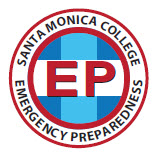Emergency Preparedness at SMC

The safety and security for students and staff of Santa Monica Community College District is a priority. As part of the Disaster Resistant California Community College consortium, SMC has the opportunity to continually improve, evaluate and modify emergency procedures and protocols. All six SMC campuses face both natural and human-made disasters. By planning, training and organizing mock exercises, SMC will be better prepared to handle these critical incidents.
As members of the community, it is our responsibility to prepare at home and at our places of employment, so that we can faithfully fulfill our role during a disaster. We can do this by attending the trainings for public employees (Standard Emergency Management System, FEMA IS 100 & IS 700) and by attending local training exercises that will help us be more prepared citizens.
Emergency preparation and procedures
Air Quality
*The college application of the air quality matrix will be based on consulting a variety of sources.
How to Report an Emergency
To report an emergency, please Dial 310-434-4300 or 911 from a campus phone.
You can also watch this video to learn more about how to prepare for and report an emergency.
Housing, Transportation, and Other Emergency Needs
Below is a short list of local resources that offer emergency relief and support to impacted individuals and communities.
- California Fire Foundation
- Disaster Relief Assistance: The Foundation provides immediate financial support to victims through $250 SAVE gift cards distributed by firefighters on the scene: CA Fire Foundation
-
Wildfire & Disaster Relief Programs: They offer various programs to support survivors, firefighters, and communities affected by natural disasters: CA Fire Foundation
- Federal Emergency Management Agency (FEMA)
-
California Specific Resources: FEMA provides information to help individuals prepare for, respond to, and recover from disasters in California, including disaster recovery centers and flood maps: FEMA
-
- California Community Foundation’s Wildfire Recovery Fund
-
Long-Term Recovery Support: This fund supports intermediate and long-term recovery efforts for communities affected by wildfires, focusing on rebuilding and restoring the lives of California’s most affected and underserved populations: CalFund
-
- Local Emergency Management Departments
-
Los Angeles Emergency Management Department: Provides updates and resources related to emergencies, including wildfires, affecting the Los Angeles area: Emergency Management Department
-
Tips on What to Do In an Emergency
- Call SMC Police (310-434-4300 or 911) from a college phone to report any emergencies.
- Study the emergency posters located in the campus classrooms and on this Emergency Preparedness Website. Know ahead of time how to get from your classroom or office to the closest designated shelter area or to exit the building by the most direct route during an evacuation. Share this information with your students.
- Faculty — Stay with your students and provide them with direction to the nearest shelter area or to the nearest exit. Keep a roster to account for your students. Notify College Police of any persons with disabilities requiring assistance. If possible, have someone stay behind with persons with disabilities until emergency personnel arrive.
- Persons with disabilities — go to stairway landings and wait for emergency rescue personnel. Stairwells are constructed with a higher fire rating than any other areas of a building. Emergency personnel responding to the building will be checking the stairway landings for persons with disabilities upon their arrival.
- Remain calm and walk do not run.
- During an evacuation, do NOT use the elevator. Take the stairs.
- Do NOT use fire alarms for individual emergencies. Use fire alarms in the event of a fire or the evacuation of a building.
- When evacuating, remember to turn off the lights and lock your office or classroom behind you.
- In the event of a lockdown- Shelter in place, stay clear of windows and wait for updates via phone, text and email.
- Keep up-to-date contact information on file with the Office of Human Resources.
- Print out, and read, the Guide to Family & Home Preparedness.
- Attend Emergency Preparedness trainings offered by SMC.
- To be prepared at home: Get a Kit, Make a Plan, Be informed.


